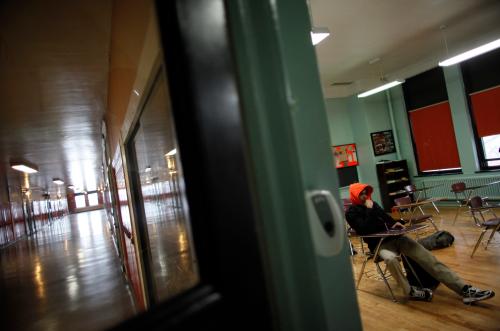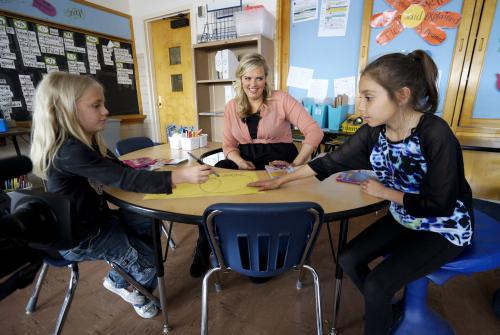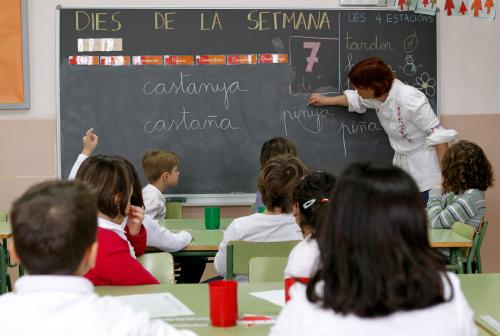Policymakers, educators, and community members often decry the large achievement and attainment gaps between English learner (EL) students and their English-proficient peers. Increasingly, attention is turning toward understanding not what’s going wrong among these students, but instead what’s going wrong with how schools educate, support, and empower these students. In the last few years, several studies have emerged documenting that simply being classified as an EL student in school can have a direct, negative impact on students’ test scores, graduation, and college-going. Possible explanations for these negative effects include that EL-classified students are often linguistically isolated with other EL students, tracked into low-level classes, and placed into classes with inexperienced teachers, all of which can harm a student’s outcomes.
New evidence on how EL classification affects teacher perceptions
An additional potential mechanism for how EL status may hurt students’ outcomes is through teacher perceptions and expectations. A long history of research has documented how teacher perceptions influence students’ achievement, and how teachers tend to have lower academic perceptions and educational expectations of marginalized student groups such as African-American and Latino students as well as girls in STEM.
In a new working paper, we assessed whether being classified as an EL student in school led teachers to have lower academic expectations of their students. We were able to take advantage of a unique policy characteristic in which states and districts use a range of different assessments and thresholds to determine who is classified as an English learner. As a result, students acquiring English with the same true English proficiency level and the same true academic skill levels are classified as ELs in some locales, but not in others. This process results in students who are, in effect, as-good-as-randomly assigned to EL or non-EL status based on their district or state of enrollment. This idiosyncrasy of EL identification policy allowed us to compare otherwise similar EL and non-EL students, estimating the causal effect of EL classification on teachers’ perceptions of students’ academic skill levels. Importantly, because we used a nationally representative dataset, our results are generalizable at the national level.
We focused on the EL classifications of incoming kindergarteners. That is, we compared teachers’ expectations over the next three years (kindergarten, first grade, and second grade) for ELs and non-ELs with similar characteristics as they entered kindergarten. In doing so, we looked across academic domains (English language arts, math, social studies, and science).
We found that EL classification resulted in teachers having lower academic expectations of their students. The effects were modest in size in kindergarten, but grew as students moved to first and second grades (reaching about a quarter of a standard deviation). Indeed, the direct effect of EL classification on teachers’ perceptions accounted for approximately half of the overall difference between how teachers perceived the academic skills of their EL and non-EL students.
We then investigated whether these effects were stronger in some settings than others. Specifically, in thinking about teachers’ perceptions of their EL-classified students, it is plausible that factors like the type of instructional program that a teacher works in may moderate the impact of EL classification on teacher perceptions. For example, a large body of research has found that bilingual instruction is beneficial for EL students. We posited that teachers working in bilingual instructional environments may have stronger connections to their students or enhanced ability to assess their EL students’ knowledge, thereby decreasing the likelihood that they hold biased expectations based on the EL label. Consistent with our hypothesis, we found that teachers in bilingual settings do not have systematically different perceptions of their EL students compared to their non-EL multilingual peers.
Implications for policy and practice
This research adds to a growing recognition that being classified as EL alters how students are treated in school and the kinds of opportunities to which they have access. Some of the ways that EL classification impacts students are purposeful and beneficial (for example, targeted instruction toward English development) while others are unintended and harmful (such as exclusion from core content). The findings from this study demonstrate that EL classification also impacts teachers’ academic perceptions of their students. This points to some important implications for policy and practice.
First, high-stakes decisions for EL students that depend on teacher judgement–such as decisions about when to exit students from EL classification or in what classes to place students–are likely vulnerable to teacher bias. These types of decisions may best be made using established, objective criteria. Standardized assessments (that accurately assess EL students’ skills) and clear policies (that are fair and implemented in a standard way for all students) are good alternatives.
Second, interventions that attempt to decrease teacher bias may help teachers better understand and accurately assess their EL students’ skills and assets. Professional development such as that centered around increasing educators’ understanding of implicit bias and empathy toward marginalized students have been shown to decrease bias. Likewise, there is evidence that home visits can help teachers develop more positive perspectives about their students and families.
Finally, expanding bilingual instructional programs can allow more students to be in settings that minimize negative teacher bias. As noted earlier, bilingual education is academically and linguistically beneficial for EL students. Results from this study suggest that one mechanism that may explain some of the benefit of bilingual education is that, unlike in English instructional settings, educators in bilingual settings are not biased against their EL-classified students. Thus, expanding these programs–a pattern occurring in many states nationwide–may allow more students to benefit from unbiased instructional settings. While we do not know what it is about bilingual settings that minimizes bias, prior research demonstrates that EL students benefit when instructed by bilingual teachers, and that students of color benefit from having a teacher of their own racial/ethnic background. Thus, it is possible that in addition to increasing bilingual programs, hiring more bilingual teachers and teachers who share the same racial or ethnic background as their EL students could also minimize bias and improve EL students’ learning opportunities.






Commentary
Do teachers have biased academic perceptions of their English learner students?
December 3, 2019